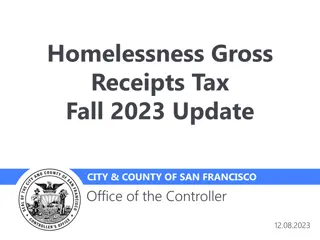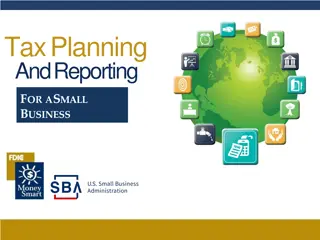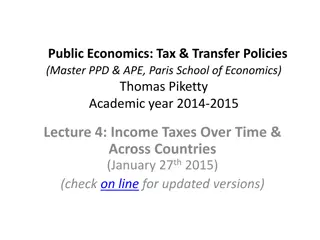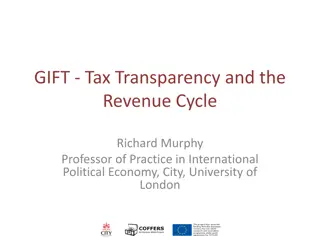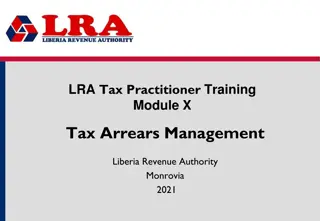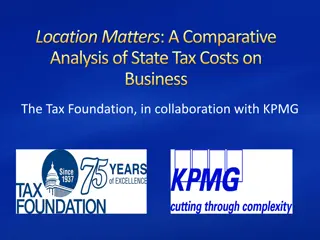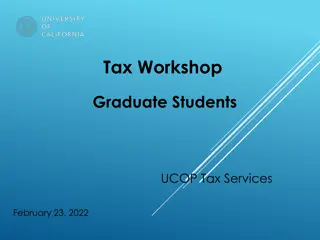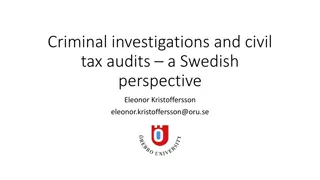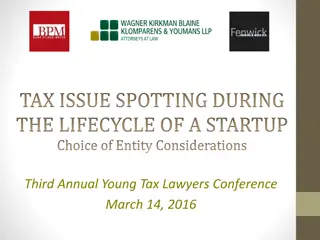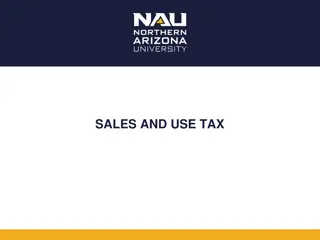Tax Considerations in Choosing Business Entities
Factors influencing the choice of business structures, including liability, control, taxation, and more. Covers various types of entities like sole proprietorships, partnerships, LLCs, and corporations. Discusses double taxation examples, co-ownership implications, and the features of different partnership models.
Download Presentation

Please find below an Image/Link to download the presentation.
The content on the website is provided AS IS for your information and personal use only. It may not be sold, licensed, or shared on other websites without obtaining consent from the author.If you encounter any issues during the download, it is possible that the publisher has removed the file from their server.
You are allowed to download the files provided on this website for personal or commercial use, subject to the condition that they are used lawfully. All files are the property of their respective owners.
The content on the website is provided AS IS for your information and personal use only. It may not be sold, licensed, or shared on other websites without obtaining consent from the author.
E N D
Presentation Transcript
Course #127 TAX CONSIDERATIONS IN CHOOSING AND FORMING A (BUSINESS) STRUCTURE OR ENTITY Douglas L. Youmans Wagner Kirkman Blaine Klomparens & Youmans LLP Mather, California A. Lavar Taylor Law Offices of A. Lavar Taylor Santa Ana, California
Factors Affecting Choice of Entity Owner liability; Owner control and participation in management; Reporting and taxation of income; Allocations of profits and losses; Changes in ownership adding owners, withdrawal of owners (because of retirement, etc.) and the like; Rights among owners with respect to dispute resolution; and Licensing (e.g., LLCs in California). 2 The State Bar of California 87th Annual Meeting, September 11-14, 2014, San Diego
Types of Structures and Entities Sole Proprietorships Co-Ownership Partnerships: General Partnerships ( GPs ) and Joint Ventures ( JVs ) Limited Partnerships ( LPs ) Limited Liability Companies ( LLCs ) Corporations: C Corporations ( C Corp ) Double taxation S Corporations ( S Corp ) 3 The State Bar of California 87th Annual Meeting, September 11-14, 2014, San Diego
Double Taxation (Example) Pass-Through* Individual Owner $100,000 N/A $100,000 C Corp Entity Level Income Tax (Individual) Owner Level Income Tax NET CASH TO OWNER $100,000 (35,000) $65,000 35.00% $65,000 (29,740) $39,260 $100,000 (39,600) $60,400 39.6% 39.6% Benefit of Single Level of Tax: *Pass-throughs include S Corps, Partnerships (GPs and LPs) and LLCs $21,140 Note: C Corp income is only taxed to the owner in this fashion if it is paid out as a dividend 4 The State Bar of California 87th Annual Meeting, September 11-14, 2014, San Diego
Co-Ownership (Tenancies-in-Common and the Like) Liability Protection: No liability protection. Tax Features: Separate Returns: No Co-Ownership return. Each co-tenant reports their own pro rata share of each item of income and expense. IRC 1031 Tax Exchanges: for co-ownership (of real estate), co-owners can independently choose whether to enter into an IRC 1031 tax-deferred exchange upon sale. Possible Partnership Treatment: Record title is not conclusive for tax purposes. Election Out of Partnership Treatment: IRC 761(a) provides for an election out of partnership treatment for certain narrow categories of activities (e.g., passive investments (not involving an active trade or business)). 5 The State Bar of California 87th Annual Meeting, September 11-14, 2014, San Diego
Partnerships (& JVs) Main Feature:Flexibility (with respect to allocations of income and expense items) Liability Protection: GPs (& JVs): No liability protection. LPs: Limited partners can get liability protection by giving up control . General partner(s) have unlimited liability exposure. 6 The State Bar of California 87th Annual Meeting, September 11-14, 2014, San Diego
Partnerships (& JVs) (Contd.) Tax Treatment:GPs (JVs) and LPs are all pass-throughs Contributions: generally, no recognition of gain on capital contributions (IRC 721), but difference between FMV and basis of property contributed must be taken into account (IRC 704(c)) Partner s ( outside ) Basis: Cash and basis of property contributed (IRC 722) Assumption of partnership liabilities treated as a contribution of cash (IRC 752(a)) Reduction of a partnership liabilities treated as distribution of cash (IRC 752(b)) which may trigger gain (IRC 733(1)) Partnership Capital Accounts: Allocations of income and expense must have substantial economic effect 7 The State Bar of California 87th Annual Meeting, September 11-14, 2014, San Diego
Partnerships (& JVs) (Contd.) Operating Profits (and Losses): Passed through/taxed to the owners, regardless of whether any cash is distributed. Distributions: Generally tax free to the extent of basis, then (if the partner does not have any outside basis): If cash or marketable entities, gain; If property, no gain or loss (the basis of the asset distributed is adjusted (to zero) so gain or loss would be recognized when it is disposed of by the partner). 8 The State Bar of California 87th Annual Meeting, September 11-14, 2014, San Diego
LLCs Main Features: Flexibility and liability protection Restricted Use: In CA, LLCs are not permitted to engage in any professional business, or any insurance, banking or trust company business. Liability Protection: Members get liability protection (the corporate shield ). Tax Treatment: Federal Tax Classification Issues: May elect to be treated as a corporation (form 8832). Default Rules (absent an election to be taxed as a corporation): Multiple Member LLCs: deemed partnerships for tax purposes. Single Member LCCs (including husband/wife owners): treated as disregarded entities for most tax purposes (Regs. 301.7701-3(b)(1)) California Tax and Fees: $800/year minimum tax plus additional annual fee based on income ( Gross Receipts Tax) The $800/year minimum tax must also be paid by LPs 9 The State Bar of California 87th Annual Meeting, September 11-14, 2014, San Diego
LLCs (Contd.) Additional Fee ( Gross Receipts Tax ) Imposed on California LLCs:Every LLC subject to California s minimum tax which does not elect to be taxed as a corporation* must pay a fee equal to: Fee $900 Total Income $250,000 - $499,999 $500,000 - $999,999 $2,500 $1,000,000 - $4,999,999 $6,000 $5,000,000 or more $11,790 (Rev & Tax Code, 17942) Total income means gross income (as defined in Rev & Tax Code 24271/IRC 61), plus the cost of goods sold that are paid or incurred in connection with the taxpayer s trade of business. *If an LLC elects to be taxed as a corporation, it is not subject to the LLC Gross Receipts tax. An LLC which elects to be taxed as a corporation can also then elect to be taxed as an S Corp. 10 The State Bar of California 87th Annual Meeting, September 11-14, 2014, San Diego
Corporations (S and C Corps) Main Feature: Liability Protection (no flexibility with respect to allocations of income and expenses) Liability Protection: Shareholders get liability protection (the corporate shield ). Note that (like limited partners), as shareholders, they have no control . Tax Treatment: C Corp: taxed as separate entity ( double tax ) S Corp: taxed as pass-through (think partnership) This distinction is purely tax 11 The State Bar of California 87th Annual Meeting, September 11-14, 2014, San Diego
Corporations (S and C Corps) (Contd.) S Corp Requirements: Must timely elect S status (15th day of 3rd month of the year); May have no more than100 shareholders (distinguish a close corporation ) May issue only 1 class of stock (determined by distribution and liquidation preferences--there can be differences in voting rights); and Shareholders are restricted: Must be US citizens, resident aliens, certain trusts and certain other S Corps. No C Corps, Partnerships or LLCs Trust Shareholders: Grantor trusts, voting trusts, certain testamentary trusts, qualified Subchapter S trusts ( QSSTs ), and electing small business trusts Grantor trust ( standard revocable trust) can remain an S shareholder for up to 2 years after the grantor s death 12 The State Bar of California 87th Annual Meeting, September 11-14, 2014, San Diego
S Corps: Special Tax Issues Invalid S Elections: IRS has authority to waive invalid S Elections and treat late elections as timely IRS has been very lenient in exercising this and treating late elections as timely One old school fix was to file a C Corp return for the first year, then elect S status for the next year. Closing Books: If shareholder terminates interest and all affected shareholders consent, S Corp can elect to allocate items of income, deductions, etc., by closing its books as of the date of termination. 13 The State Bar of California 87th Annual Meeting, September 11-14, 2014, San Diego
C Corps: Special Tax Issues No gain/loss on incorporation (if requirements of IRC 351 are satisfied) Liabilities in Excess of Basis: Excess of liabilities contributed over the shareholder s basis in the property contributed is taxable (IRC 357) Mitigation of Double Taxation: Payment of reasonable compensation to shareholder-employees excess compensation gets taxed as a dividend (contrast S Corp issues where the IRS requires minimal compensation (in order to extract payroll taxes)) Payment of other deductible payments to shareholders Retaining earnings Graduated Corporate Tax Rates (IRC 11(b)): Graduated corporate tax rates do not apply to qualified Personal Service Corporations (taxed at 35% rate) 14 The State Bar of California 87th Annual Meeting, September 11-14, 2014, San Diego
S Corp Taxation No gain/loss on incorporation (if requirements of IRC 351 are satisfied) Liabilities in Excess of Basis: Excess of liabilities contributed over the shareholder s basis in the property contributed is taxable (IRC 357) Pass-through treatment: Generally no corporate federal income tax, accumulated earnings tax, or personal holding company tax Exceptions: IRC 1374 (built-in gains) and 1375 (passive investment income) State Law: California imposes a 1.5% tax on S Corp taxable income, with an $800 annual minimum tax Distributions: If cash, generally tax free to the extent of basis, then ordinary/dividend income If property, possible double tax Gain to corp, as well as Possible ordinary/dividend income 15 The State Bar of California 87th Annual Meeting, September 11-14, 2014, San Diego
Corporations Income Splitting C Corps: Income Splitting limited by: sham transaction and business purpose doctrines; anticipatory assignment of income doctrine; and IRS power to reallocate income and other items under IRC 482. S Corps: Income Shifting: S Corp can be used to shift income if there is a bona fide transfer of stock ownership (as a pass-through, income follows/is allocated to the shareholders, pro rata, based on their stock ownership) IRS may adjust compensation to S Corp s shareholder s family member providing services to S Corp to reflect reasonable compensation (IRC 162(a)(1)) 16 The State Bar of California 87th Annual Meeting, September 11-14, 2014, San Diego
Example Income Splitting (Assume: $200,000 Worth of Income) C CORP PASS-THROUGH Corporation Shareholder S Corp, Partnership or LLC Taxable Income $100,000 $100,000 $200,000 Federal Income Tax (22,250) (21,293) (50,131) Net Cash $77,750 $78,707 $149,869 Net Cash to C Corp $77,750 N/A Net Cash to Entity and Owner $156,457 $149,869 Net Cash to Pass-Through (149,869) INCOME SPLITTING ADVANTAGE OF C CORP $ 6,588 17 The State Bar of California 87th Annual Meeting, September 11-14, 2014, San Diego
Corporations Deductibility of Losses Operating Losses: C Corp losses stay with the C Corp in form of net operating loss ( NOL ) carryovers NOL s may be carried back 2 years and forward 20 years S Corp shareholders may deduct S Corp losses against their other income, subject to the following limitations: Shareholder s Basis (IRC 1366(d)): Aggregate (i) the investment in their stock at the end of the year; and (ii) the amount of any/all loans that shareholder might have made directly to the S Corp 18 The State Bar of California 87th Annual Meeting, September 11-14, 2014, San Diego
Basis and Loss Limitations Pass-Through Entities: losses limited to owner s basis in entity GPs, LPs & LLCs: Subject to the at-risk rules, partners may deduct partnership losses to extent of their adjusted basis in their respective interests (which basis includes their pro rata share of partnership debt) (IRC 704(d)) At-Risk Rules (IRC 465): Limit amount of losses deductible to amount taxpayer has at-risk in the activity Deductions disallowed by at-risk rules may be allowed in a subsequent year if/when the taxpayer increases their amount at-risk 19 The State Bar of California 87th Annual Meeting, September 11-14, 2014, San Diego
Basis and Loss Limitations (Contd) S Corps: Shareholders may deduct corporate losses to extent of their basis in their stock plus amounts loaned to the corporation by shareholder. Personal guarantees do NOT count until paid on. (IRC 1366(d)(1)) Examples: Shareholder s Basis with Shareholder Debt. In exchange for 100% of stock, A contributed $500,000 to form ABC, Inc., an S Corp. A also loaned $450,000 to ABC, Inc. A s stock basis is $500,000 and his debt basis is $450,000. In Year 1, ABC, Inc. has a loss of $750,000 at the end of the first year. A s stock basis is reduced to $0 and his debt basis is reduced to $200,000. Shareholder s Basis with Third-Party Debt. In exchange for 100% of stock, A contributed $500,000 to form ABC, Inc., an S Corp. ABC, Inc. also borrowed $450,000 from a third-party which A guarantied. A s stock basis is $500,000 and his debt basis is $0. In Year 1, ABC, Inc. has a loss of $750,000 at the end of the first year. A s stock basis is reduced to $0. He cannot deduct any portion of the loss in excess of $500,000 because he has no debt basis. 20 The State Bar of California 87th Annual Meeting, September 11-14, 2014, San Diego
Basis and Loss Limitations (Contd.) C Corps: Shareholders may not deduct corporate losses 21 The State Bar of California 87th Annual Meeting, September 11-14, 2014, San Diego
Corporations Other Tax Considerations Passive Loss Limitations Do not apply to widely-held C Corps Charitable Contributions C Corps cannot claim charitable contribution deductions in excess of 10% of their taxable income computed with certain modifications (IRC 170(b)(2)) 5-year carryforward of unused deductions subject to this limitation (IRC 170(d)(2)) Shareholder Loans Shareholder loans receive short term capital loss treatment as nonbusiness debts under IRC 166(d)(1)(B) Exception: Loans generating business bad debt are deductible as an ordinary loss under IRC 165(a) 22 The State Bar of California 87th Annual Meeting, September 11-14, 2014, San Diego
Corporate (Tax) Accounting Methods C Corps: Cash method of accounting is generally NOT permissible for: C Corps; partnerships which have a C Corp as a partner; and/or tax shelters (IRC 448) Exceptions: Farming businesses; qualified personal service corporations ( PSCs ); and entities with Gross Receipts of < $5,000,000 S Corps: May adopt any permissible method of accounting. (IRC 446(c)) 23 The State Bar of California 87th Annual Meeting, September 11-14, 2014, San Diego
Corporations Choice of Fiscal Year C Corps: Taxpayer s (C Corp s) annual accounting period (IRC 441(a)) S Corps: Calendar year unless business purpose established Business Purpose (Rev. Proc. 87-32 (1987-2 C.B. 14)) Partnerships: majority interest taxable year the taxable year of partners holding more than 50% interest in partnership profits and losses. 24 The State Bar of California 87th Annual Meeting, September 11-14, 2014, San Diego
Corporations Sales of Stock Shareholders will generally recognize capital gain or loss upon the sale of their stock (IRC 1001(a)) Exceptions: Holding period requirement is not met Shareholder is a dealer in the securities Corporation is a collapsible corporation (defined in IRC 341) Sale is structured as a reorganization IRC 1244 Stock: Possible ordinary loss treatment if corporation issues IRC 1244 small business stock and IRC 1244 requirements are satisfied Qualified Small Business Stock: Individuals and non-corporate investors may qualify for exclusion of 50% to 100% of any gain realized if the stock is held 5 years. (IRC 1202) 25 The State Bar of California 87th Annual Meeting, September 11-14, 2014, San Diego
Corporations Redemptions In IRC 302 or 303 redemptions, shareholders will realize and recognize capital gain, corporations will not receive any deduction. Assumes that: (i) the corporation is not a collapsible corporation; (ii) the holding period requirement has been met; and (iii) the shares are a capital asset in the shareholder s hands. IRC 302: 3 types of redemptions qualify for capital gains treatment: A complete termination of the shareholder s interest (IRC 302(b)(3)) A substantially disproportionate distribution with respect to the shareholder (IRC 302(b)(2)) A distribution that is not essentially equivalent to a dividend (IRC 302(b)(1)) IRC 303: Redemption to pay death taxes and funeral and administrative expenses qualifies for capital gains treatment if IRC 303 requirements satisfied. 26 The State Bar of California 87th Annual Meeting, September 11-14, 2014, San Diego
Corporations Liquidation & Dissolution C Corps: Distributions of appreciated property subject to double taxation If property, possible double tax Gain to corp, as well as Possible ordinary/dividend income S Corps: Distributions of appreciated property by S Corps (provided they do not involve built-in gains (IRC 1374)) are effectively taxed only once. 27 The State Bar of California 87th Annual Meeting, September 11-14, 2014, San Diego
Corporations Estate Planning C Corps: Transmission of Wealth: Shares of stock will pass under shareholder s testamentary documents (or appropriate intestacy statute) unless the C Corp s governing instruments provide otherwise Basis of any shares so transferred will be stepped up to their date of death/706 estate tax value (IRC 1014) S Corps: Transmission of Wealth: Person inheriting stock in S Corp from individual dying post-August 20, 1996, required to treat as IRD person s pro rata share of any item of income of the S Corp that would have been IRD if acquired directly from the decedent. Basis of inherited stock reduced by extent to which its value is attributable to IRD. Income tax deduction allowed for estate tax attributable to IRD items. 28 The State Bar of California 87th Annual Meeting, September 11-14, 2014, San Diego
Example Tax Consequences of an Owner s Death or the Purchase of an Interest (Assume: Value of Inventory at Date of Death is $1,000,000) C Corporation S Corporation Partnership or LLC Gross Entity Sales $1,000,000 $1,000,000 $1,000,000 Less: Entity Basis (0)* (0) ($1,000,000)** Gain $1,000,000 $1,000,000 $ (0) 39.6% Federal Tax ($ 350,000) ($ 396,000) $ (0) 35% ADVANTAGE: C Corp v. S Corp S Corp v. S.P. S Corp. v. S.P. $46,000 N/A N/A N/A N/A N/A $350,000 $396,000 * There is no increase in the basis of the entity s assets, only the shareholder s stock. **Basis of assets increases to fair market value on death. 29 The State Bar of California 87th Annual Meeting, September 11-14, 2014, San Diego
Built-In Gain and Loss Rules Partnerships and LLCs Taxed as Partnerships: Built-in gains/losses in property contributed to partnership are allocated to contributing partner (IRC 704(c)) S Corps: Sale of assets during recognition period by S Corp that used to be C Corp is subject to built-in-gains tax. Built-in gain tax can be eliminated if S Corp sells appreciated assets originally acquired when it was a C Corp only after recognition period expires Recognition Period is generally 10 years 30 The State Bar of California 87th Annual Meeting, September 11-14, 2014, San Diego
General Tax Comparisons ITEM PARTNERSHIPS (LLCs) CORPORATIONS Operating Profits (Income) Partnerships are not taxed as separate entities. Partnership income and losses flow directly to the partners (individual) tax returns. C Corps are taxed as separate legal entities. Shareholders are taxed on dividends paid and distributions made by the corporation. S Corps are not taxed as separate legal entities. S Corp income and losses flow directly to the shareholders tax returns. Losses Deductible by Owners Yes, in that amount equal to the sum of the amount invested plus a prorated share of partnership liabilities (i.e., the partner s outside ( at risk ) basis). C Corps no. S Corps limited to sum of the amount invested and the amount loaned (directly) to the corporation. Subject to Passive Activity Loss Rules (IRC 469) Yes C Corps generally no. S Corps limited. Special Allocations Possible, if they have substantial economic effect. No. 31 The State Bar of California 87th Annual Meeting, September 11-14, 2014, San Diego
General Tax Comparisons (Contd.) ITEM PARTNERSHIPS (LLCs) CORPORATIONS Fiscal Year (IRC 444, 7579 and 280H) May end up to 3 months earlier than years of principal partners. C Corps any fiscal year. S Corps may end up to 3 months earlier than year of principal stockholders. Tax-Free Fringe Benefits Limited C Corps all permitted by law. S Corps limited. Tax-Free Merger (IRC 368) No, but LLCs can. C Corps yes. S Corps yes. Accumulated Earnings Tax (IRC 531) No. C Corps yes. S Corps no. Personal Holding Company Tax (IRC 541) No. C Corps yes. S Corps no. 32 The State Bar of California 87th Annual Meeting, September 11-14, 2014, San Diego
Federal vs. California Tax Comparisons FEDERAL TAX CALIFORNIA TAX (a) 100% taxed to owner (b) $800 annual fee for LPs (a) 100% taxed to owner (b) $800 annual fee (c) Gross receipts tax (a) Usually 100% taxed to owner (b) Possible built-in gains tax (c) Possible passive activity loss limitations (d) $800 minimum tax (e) 1.5% net income tax 100% taxed to corporation Partnerships 100% taxed to owner (no entity tax) LLCs 100% taxed to owner (no entity tax) S Corps (a) Usually 100% taxed to owner (b) Possible built-in gain tax (c) Possible passive activity loss limitations C Corps 100% taxed to corporation 33 The State Bar of California 87th Annual Meeting, September 11-14, 2014, San Diego
Comparison: LLC Gross Receipts Tax vs. S Corp Tax Assume a 20% Net Profit Margin LLC Gross Net Income $40,000 Gross Sales $200,000 Receipts Tax* S Corp Tax $000 $800 $70,000 $350,000 $900 $1,050 $140,000 $700,000 $2,500 $2,100 $400,000 $2,000,000 $6,000 $6,000 $1,200,000 $6,000,000 $11,790 $18,000 *These numbers do not include the $800 annual minimum tax for LLCs 34 The State Bar of California 87th Annual Meeting, September 11-14, 2014, San Diego
Payroll Tax Issues/Differences S Corps: Reasonable salary paid to employee-owner is subject to employment taxes (Rev. Rul. 59-221) Dividends in lieu of compensation treated as wages and subject to withholding (Rev. Rul. 74-44) C Corps: Must withhold payroll taxes from all employees salaries. C Corp will then match amounts withheld (only this matching portion of the FICA taxes forwarded to the IRS is deductible by the C Corp). Any shareholder who works for a C Corp is treated the same as other employees No self-employment tax issues. Partnerships: Partners must pay self-employment taxes on their share of the ordinary income of the partnership and any/all guaranteed payments received (IRC 1402(a)) Limited partners not required to pay self-employment tax on their share of ordinary income except for guaranteed payments received for services (IRC 1402(a)(13)) But seeRenkemeyer, Campbell & Weaver, LLP v. Commissioner, 136 T.C. 137 (2011); See also Howell v. Commissioner, T.C. Memo 2012-303. Prop. Regs. 1.1402(a)-2(h)(5) 35 The State Bar of California 87th Annual Meeting, September 11-14, 2014, San Diego
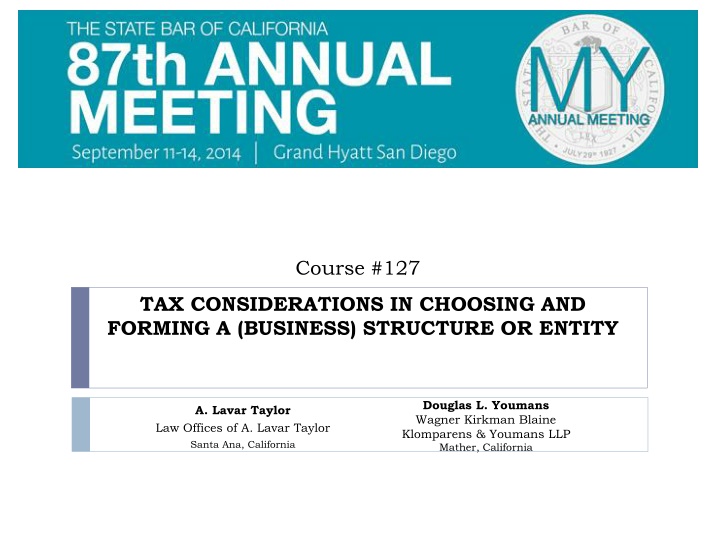



![Town of [Town Name] Real Estate Tax Rates and FY 2024 Budget Summary](/thumb/62211/town-of-town-name-real-estate-tax-rates-and-fy-2024-budget-summary.jpg)
